|

 Up
Up 
 Wright Kites
Wright Kites
and Gliders

(You are here.)
 Down
Down




  Need
to Need
to
find your
bearings?
Try
these
navigation aids:
If
this is your first
visit, please stop by:
Something
to share?
Please:



|
|
|
Available in Française, Español, Português, Deutsch, Россию,
中文,
日本, and others.
|
1899 Experimental Kite – In
the early summer of 1899, Wilbur Wright discovered that if he drew
together the opposing corners of a long, narrow box, the box would
twist. . He thought he might use this method to control a biplane,
twisting the wings to turn one wingtip up and the other down
simultaneously and causing the biplane to roll. He built this
experimental kite or "model glider" to test that idea. It worked.
|
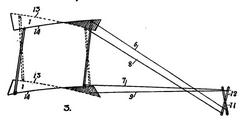 | |
The 1899 Wright kite was controlled from the ground with four strings
attached to two sticks. By angling the sticks, the operator could roll
the kite.
|
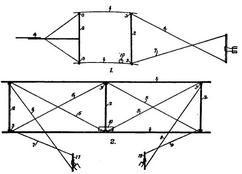
|
1900 Glider
– A year later, Wilbur was ready to try his idea on a man-carrying
flying machine. He and his brother Orville built a small biplane glider
and took it to Kitty Hawk, North Carolina to test it. (They chose Kitty
Hawk because it had consistently strong winds that they needed to launch
the glider.) The control system seemed to work, but the glider did not
produce enough lift to carry a man aloft. They decided to try a larger
glider.
|
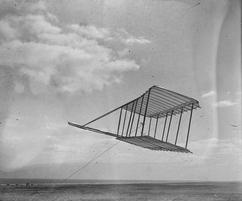
The 1900 glider, flown as a kite. The Wright kites all their gliders to
measure lift and drag.
|
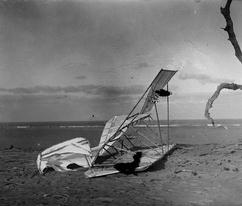
At one point, a gust of wind snatched the 1900 glider and nearly
dashed it to pieces. But the brothers repaired it and were soon
flying it again.
|
1901 Glider
– This Wrights returned to Kitty Hawk with a glider that offered
almost twice as much wing area as their first. Unfortunately, it still
did not generate as much lift as they expected. Additionally, the
controls did not work as well on this glider as they had on the first.
This convinced the Wrights that they need to do basic research in aerodynamics, testing different wing shapes in a
homemade wind tunnel.
|
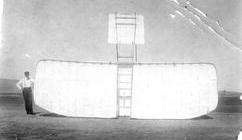
Orville standing beside the 1901 Wright Glider. At the time, it was the
largest gliding machine anyone had ever flown.
|
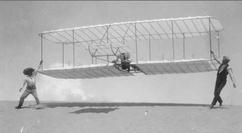
Orville and Dan Tate launch Wilbur aboard the 1901 Wright Glider.
|
1902 Glider
– The Wrights identified an efficient wing shape in their wind tunnel,
then built an aircraft around it. Their third glider not only produced
the expected lift, it was also responsive to its controls. Initially,
the glider used wing
warping to control roll and a forward elevator for pitch.
After a few modifications, it also used a
trailing rudder for yaw. This allowed the Wrights, for the first time, to
navigate the air in all three dimensions.
|
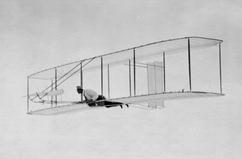
The 1902 glider was the first of the Wright's aircraft to have a tail.
Initially, the tail had two fixed surfaces.
|
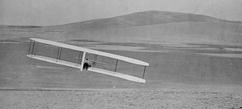
After a series of test flights, the Wrights decided to convert the tail
into a movable rudder with a single surface.
|
1911
Experimental Glider – Although the Wrights finished their glider
experiments in 1902 to pursue powered aviation, they remained fascinated
with gliding. In 1911, Orville returned to Kitty Hawk with a new glider
designed to test some of the ideas he and Will had been kicking around
for almost a decade. With this machine, he set the world's first soaring
record, hovering above the sand at Kill Devil Hills for 9-3/4 minutes.
|
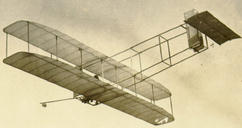
The Wrights told the press that the 1911 glider would be used to test an
"automatic stabilizer" – a primitive autopilot – but that didn't happen.
|
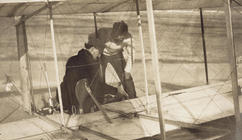
Orville Wright consulting with Alec Olgilvie, a visiting pilot from
England, in the cockpit of the 1911 glider. Olgilvie flew a glider
that Orville designed in 1909 (see below).
|
|
For yet another Wright glider see the
1909 Wright Glider in
Aviation's Attic. It wasn't built by the Wright brothers, but it was
based on their designs. |
|
|

